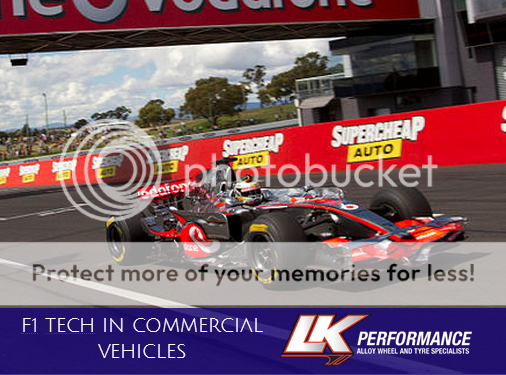What technology developed in F1 Racing has made it into commercial vehicles?
Posted on: 31/07/2014
Image Credit: By NRMA Motoring and Services from Sydney, Australia via Wikimedia Commons
Aside from being a thrilling spectator sport and generating over a billion pounds of revenue each year, Formula 1 racing has also had a huge influence on the development of our daily road cars through the expertise which is designed to make the cars go as fast as possible around some of the world's most famous circuits. Although not all technology on cars is developed solely through F1, for example a lot of the safety features such as air bags, radar guided cruise control, satnav and other electronic gizmos we use every day. There is still a vast array of fundamental car design which happens directly as a result of this sport.
History of road cars and race cars
The focus of the series has also changed over the years to enable this synergy between road cars and race cars. In the early days, to make your car go faster you needed more power and more grip. This witnessed the birth of the high power V12s and turbocharged engines. By 1986 the power output figures of the engines were becoming simply out of this world, with the cars able to produce in excess of 1200bhp! However this was contributing to having a huge detrimental effect on reliability, and most importantly the safety of the cars, resulting in an average death rate of around 2 drivers per season. The death of Ayrton Senna in 1994 was one of the most significant and really marking a turning point in the sport with the aim changing to make the cars more stable and reliable, all aiding to the safety of the drivers.
The link between road cars and race cars has been forged more strongly over the last 20 years as a result of this change in focus. Teams started looking more closely at the crash structures of the vehicles, together with the suspension and drivetrain, and more notably - the aerodynamics - to make their cars go faster around a circuit rather than using outright power. The 2014 season in particular has driven the F1 game into the 21st century with the biggest change in rules over the last 5 years.
Engine development
Image Credit: Renault 1.6 V6 Turbo Engine - compact in size but packs a punch!
Engine development has always been at the forefront of F1 design, with companies such as Shell developing fuels, oils and other fluids as a direct partnership with Ferrari, however it's how the car puts this power down that's had a major revamp. Up until recently F1 teams have focused on developing sophisticated traction control systems to aid in the power delivery. Although now scrapped from racing to make it more testing for these elite drivers, the technology has translated into safer road cars, with most cars now days having some form of electronic traction and/or stability control to make the car's handling more predictable and safer in adverse weather conditions. Some of the world's most powerful supercars and hypercars rely on these traction systems to make their cars driveable by anyone wealthy enough to afford them.
The car body
As mentioned earlier, a lot of work has gone into the design of the body and chassis of F1 cars to make them safer and lighter.
Catarham F1 team crash testing parts of their 2014 car Computer-aided design has assisted teams in identifying weak points and assessing the impact of high g-force crashes of the body of the car. It's not uncommon to see crashes in F1, but amazing to see that after a 150mph trip into a wall, drivers are able to get out of the vehicles without a single scratch. Of course there are other aspects which contribute to this such as absorbent crash barriers and safety helmets; a large contribution is the way in which the car can withstand such an impact stems from the clever design of the bodywork and chassis. This together with the development of very clever materials such as carbon fibre has resulted in cars that are lighter, stronger and ultimately faster than the next competitor. Road cars and in particular high end super car manufacturers have directly applied these technologies to make some of the fastest but also best looking cars on the planet.
Raikkonen crash Silverstone 2014: 150mph into a wall and walks away unharmed as a result of years of impact testing Image Credit
Aerodynamics
Another aspect of car design that can find its roots in F1 is undoubtedly aerodynamics. Allied to the advancement of very clever body shapes and construction of light and strong materials, F1 teams spend a larger proportion of their development time in the wind tunnel, assessing how the air flow helps grip levels around a track. Road cars have used some of this know-how to produce active aero and generally more "slippery" body shapes to make cars more stable at high speeds but also more fuel efficient.
Power
In addition to making cars safer and stickier to the tarmac around a race course, a huge amount of investment has of course gone into power and drivetrain development. Engines are now more fuel efficient through the use of smaller, turbocharged power units and gearboxes which have 8 forward speeds selected via steering wheel mounted paddles also feature on every car. In both cases this is technology which has directly influenced road car design. The traditional gearstick is being replaced with paddles even at the most affordable end of the sports car range, for example the new Renault Clio 200 no longer uses conventional transmission. Cars like the Nissan GTR and most of VAG's DSG equipped range were always designed with such a gearbox in mind, with added benefits meaning reduced shift time and better use of the engine's available power. Manufactures are also downsizing to 1.6 turbocharged engines in favour over 2.0L+ naturally aspirated engines.
Recent developments



